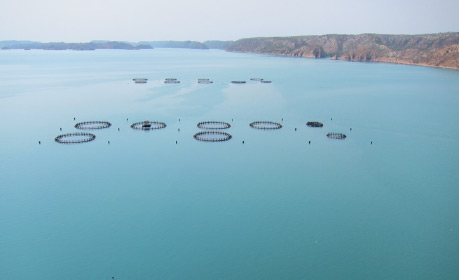As part of its commitment to developing a sustainable marine aquaculture industry, the State Government is establishing aquaculture development zones.
An aquaculture development zone is a designated area of water selected for its suitability for a specific aquaculture sector (for example marine finfish or shellfish). The zones provide ‘investment ready’ areas of water with strategic environmental approvals and management policies already in place. This allows commercial aquaculture operations to be set up without the need for lengthy, complex and expensive approval processes.

Active Zones
To date, three aquaculture development zones have been established in Western Australia: one in the Kimberley, one in the Mid-West and the latest one in Albany.
Albany Aquaculture Development Zone
The State Government has invested $1.3 million to identify and establish an Aquaculture Development Zone on the south coast of WA. A new zone on the south coast off Albany will offer “investment-ready” opportunities for large-scale commercial shellfish aquaculture. At full capacity, resulting shellfish farming operations are expected to create more than 200 direct jobs.
A  Management Framework has been developed to identify, manage, and mitigate risks of environmental impact that may be associated with aquaculture to safeguard environmental values. This document is designed as a common reference point for both industry and community. It aims to provide clarity to industry on the standard that they will be held to, and confidence within the community that aquaculture development within the Albany zone will not come at an unacceptable environmental cost.
Management Framework has been developed to identify, manage, and mitigate risks of environmental impact that may be associated with aquaculture to safeguard environmental values. This document is designed as a common reference point for both industry and community. It aims to provide clarity to industry on the standard that they will be held to, and confidence within the community that aquaculture development within the Albany zone will not come at an unacceptable environmental cost.
The Zone encompasses four separate areas, covering around 800 hectares. These are:
- an area in Oyster Harbour, comprising 500 hectares;
- two areas in King George Sound (near Mistaken Island and in Frenchmans Bay); and
- an area in Princess Royal Harbour (in Shoal Bay).
The Zone was declared in two stages:
First stage: Oyster Harbour area (declared 7 August 2020).
it is the first marine shellfish aquaculture development zone established in Western Australia. The Department of Primary Industries and Regional Development is currently undertaking a site allocation process for this zone
Existing farms operate within the boundaries of the  Albany Aquaculture Development Zone - Oyster Harbour Area. These existing sites occupy 173.819 hectares out of the total Oyster Harbour area.
Albany Aquaculture Development Zone - Oyster Harbour Area. These existing sites occupy 173.819 hectares out of the total Oyster Harbour area.
Second stage: Princess Royal Harbour and King George Sound (declared 2 December 2021).
Kimberley Aquaculture Development Zone
The Kimberley Aquaculture Development Zone is in Cone Bay, at the northern end of King Sound, about 215 kilometres north-east of Broome. Declared by the Minister for Fisheries in 2014, this was the first aquaculture development zone for marine finfish to be established in Western Australia. This zone is fully allocated.
Kimberley Aquaculture Development Zone. Click on the image above to download a larger version of the map.
Information in relation to the Department of Water and Environmental Regulation’s Office of the Environmental Protection Authority’s assessment process with respect to the Kimberley Aquaculture Development Zone can be found at the following
link.
Kimberley Aquaculture Development Zone Environmental Reporting
Aquaculture operator, Barramundi Group (MPA Fish Farms), currently conducts all environmental monitoring and management activities in accordance with an EPA approved EMMP and has made a commitment to make environmental reporting data publicly available.
The most recent environmental compliance reports can be viewed below:
Mid-West Aquaculture Development Zone
The Mid-West Aquaculture Development Zone is located across an area of open water between Geraldton and the southern region of the Abrolhos Islands group. It was declared in 2017 as the state’s second marine finfish aquaculture development zone. This zone is fully allocated but not yet operational.
Information in relation to the Department of Water and Environmental Regulation’s Office of the Environmental Protection Authority’s assessment process with respect to the Mid-West Aquaculture Development Zone can be found at the following
link.
Further information